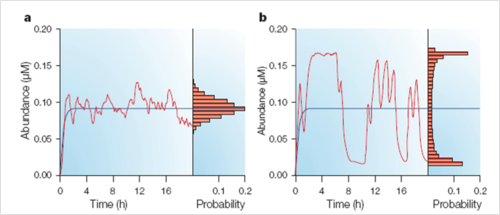Promoter Kinetics
Promoter Kinetics and Stochasticity of Gene Expression
A fast transition between promoter states is one assumption that has to be true in order for deterministic gene expression models to resemble experimental data (Collins et. al., 2003). This is because promoters that remain in an active state allow many "short bursts" of mRNA synthesis; the same rate limiting steps that inhibit turnover time of promoter activation also force the promoter to stay in a repressed state for longer time periods during which production of mRNA is very low.
Diagrams of protein accumulation in genes with slow promoter transitions (between induction and repression) are often characterized by two bistable states that mirror the state of the promoter (Figure 1). This is contrasted with the steady-state concentration of proteins that are expressed by promoters with fast transition kinetics. While most biochemical processes in prokaryotes are assumed to have such a fast turnover rate of promoter state that the effect can be ignored, the kinetics of the expression of some genes are a source of a large amount of variability. The variable number of mRNA synthesis is also referred to as transcriptional bursting or transcriptional efficiency.
Figure 1 was obtained at http://www.ncbi.nlm.nih.gov/sites/entrez?db=pubmed&uid=15883588&cmd=showdetailview&indexed=google permission pending
Figure 1 visually depicts the comparison between the steady state of protein production achieved by a promoter with a fast turnover rate (a), and the bistable state of protein production resulting from a slow promoter turnover rate (b).
